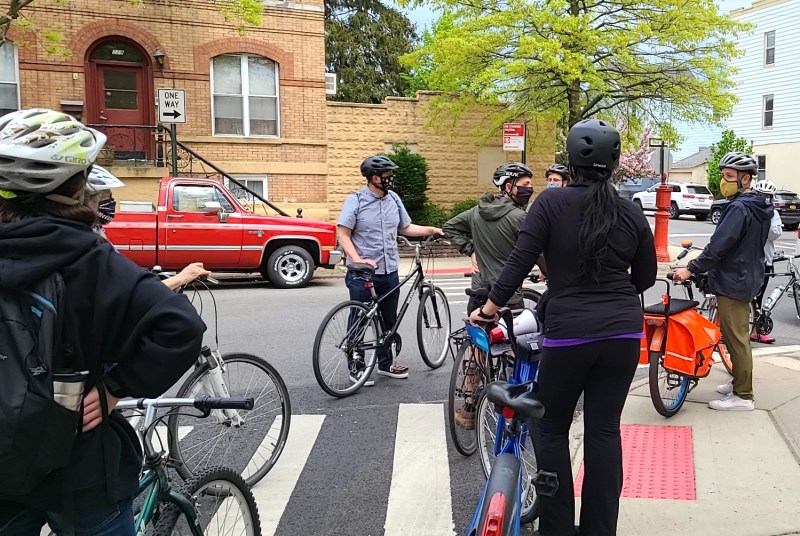OPINION: Making Cycling Accessible for All New Yorkers
A candidate for City Council in Brooklyn describes what it would take to open up cycling for Black, brown and working-class bikers.

This is the latest coverage of the race to succeed term-limited Council Member Brad Lander in the Park Slope-centered District 39. Previously, we covered the race in a general news story, but have also published three opinion pieces from candidate and prolific writer Justin Krebs. This piece is by Shahana Hanif.
As a survivor of Lupus who had both hips and my left shoulder replaced, I have always been afraid of riding a bicycle. Cycling anywhere in the city can be dangerous, but it is especially dangerous where I live in Kensington, a working-class, immigrant neighborhood with known deadly intersections, sparse and disconnected bike lanes, and few bike shops to get a flat fixed. For New York to become a true biking city it must address four core problems: lack of cycling infrastructure, community engagement around streets, NYPD involvement in bike safety, and access to bike shops and services.

Parts of the city have adequate infrastructure for cycling and pedestrians but many others — especially Black, brown, and immigrant neighborhoods — have been passed over for protected bike lanes and open-streets infrastructure that allow more people to cycle safely. Key biking roads in District 39 are interspersed with highways and deadly intersections, making conditions dangerous for cyclists and pedestrians.
In my district, Borough Park is a “Priority Bicycle District,” meaning an area with high incidents of bike injuries or deaths. Only 8 percent of streets in Borough Park have bike lanes, compared to 29 percent in more affluent neighborhoods such as Park Slope and Carroll Gardens. Neither percentage is enough. Updating streets and investing in programs like Vision Zero will curb our dependency on cars and make streets safer for day-to-day travel for both cyclists and pedestrians. Also, many New Yorkers must carry bikes up flights of stairs to their apartments, because there is nowhere to safely store them outside. Expanding Citi Bike across all neighborhoods is a great start toward addressing these issues, but it also requires follow-through in street infrastructure, which has not happened. Equitable infrastructure also must take into account the city’s working cyclists, such as food-delivery workers, including fixing unsafe working conditions by providing access to restrooms, which is especially important for app-based delivery drivers who are restricted from using restrooms at restaurants.

Our open streets program, which includes outdoor dining and performances, has flourished during the pandemic. COVID-19 showed legislators the crucial need for expanded and permanent open spaces in our city. For some neighborhoods, the Open Streets program has been an opportunity for community members to work together and create alternatives to car-centric streets. In many more areas, particularly in Black, brown, and immigrant neighborhoods, open streets are non-existent because of a lack of volunteers and resources. No community should be expected to provide free labor to provide an essential service, especially those that lack time and infrastructure.
Mayor de Blasio’s new City Cleanup Corps, and the $4 million in support the city has pledged for open streets partners, may alleviate some maintenance burdens. But the city must step up support for community groups if it wants to sustain the Open Street program.
It’s like when I built Avenue C Plaza, a community gathering space in Kensington: We were supported by the Department of Transportation’s Neighborhood Plaza Partnership program, which provided training to neighborhood volunteers in communities without robust local organizations. No program can long survive only on volunteers. We must create a Neighborhood Stewardship Initiative, which would pay local community members for maintenance and open streets support.

Policing also presents a critical barrier for cyclists of color, especially working-class immigrant delivery workers, who have a higher risk of harassment and violence at the hands of the authorities. Immigrant and/or undocumented cyclists are less likely to report injuries and dangerous driving and road conditions because of the fear of deportation and other consequences of dealing with NYPD and ICE. The upcoming handover of cycling and other crash investigations from the NYPD to the DOT is a good start, but the NYPD will still be involved in incident criminal investigations after the fact, which is a major hurdle for safety and a deterrent to cycling accessibility. Removing the NYPD from bike safety would encourage more riders to take to the streets and make cycling a more accessible form of transportation, work, and recreation.
WE JUST BIKED DISTRICT 39?
I felt safe cycling from Kensington to Park Slope hugged in a group of bikers but we have to show up for a bikeable NYC!
THANK YOU @sunrisemvmtnyc & @CBIDems for hosting this Day of Action and @bradlander, @kangarooni_, & @BrooklynSpoke for leading! pic.twitter.com/c1IfypvNtd
— Shahana Hanif ? (@ShahanaFromBK) May 2, 2021
Another often overlooked barrier to cycling access is the cost of purchasing and maintaining a quality bicycle. The cycling community traditionally caters to men with disposable income, making many bike and repair shops not only unwelcoming spaces for new or working-class cyclists — especially those of color — but also sparse in neighborhoods like mine. I learned how to ride a bike as an adult and was taught by a women-of-color bike collective on a borrowed bike after my bike was stolen. I want to support programs and bike cooperatives like these, which teach women how to bike, repair bikes, and feel comfortable biking by supporting outreach led by cyclists of color. During our district bike ride in April, organized and led by women cyclists of color, I felt safe and supported riding in Kensington, surrounded by a group of experienced cyclists that understood my challenges navigating bike infrastructure. Let’s make the city a place where more women and working-class cyclists feel safe every day.
Shahana Hanif (@ShahanaFromBK) is a candidate for City Council in the 39th District, encompassing Cobble Hill, Carroll Gardens, Columbia Waterfront, Gowanus, Park Slope, Windsor Terrace, Borough Park, and Kensington.